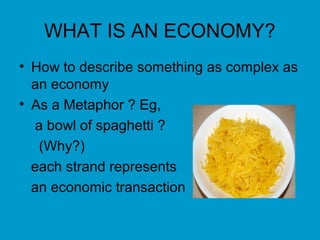
Circular flow
- 1. WHAT IS AN ECONOMY? • How to describe something as complex as an economy • As a Metaphor ? Eg, a bowl of spaghetti ? (Why?) each strand represents an economic transaction
- 2. As a machine ?
- 3. As a biological system
- 4. As a model • Economists thankfully have developed a simple model ( to represent the major areas of activity and flows of money between them) known as “The Circular Flow of Income” • FEATURES: • 5 major areas (or “Sectors” of activity) • Income/money flows between these sectors
- 5. CIRCULAR FLOW OF INCOME 2 Sector Model 1. Household Sector comprises total population - who are consumers - and producers (owners of resources) - Households receive income for providing resources ( land, labour, capital,enterprise) to the business sector 2. Business Sector – where all production occurs and sells goods and services
- 6. 2 Sector Model Income (Y) Household Business Consumption
- 7. 3 Sector Model 3. Finance Sector – where people SAVE and BORROW money, eg, banks, building societies, credit unions, superannuation companies, sharemarket, etc. (Business borrowing is known as INVESTMENT)
- 8. 3 Sector Model Household Business Finance Savings Investment
- 9. 4 Sector Model 4. Government Sector – (Federal, state and local) where the Government TAXES people (and businesses) and SPENDS money (eg subsidies to businesses, welfare payments to households)
- 10. 4 Sector Model Household Business Finance Savings Investment Govt. Tax Govt Spending
- 11. 5 Sector Model 5. Overseas Sector – There are many flows of money in and out of Australia. The most well known flows are payments overseas (IMPORTS) and payments to Australians (EXPORTS) for goods.
- 12. 5 Sector Model Household Business Finance Savings Investment Govt. Tax Govt Spending Overseas Imports Exports
- 13. Equilibrium: Leakages and Injections Leakages (Red Lines) are money that leaves the circular flow eg. – Savings – Tax – Imports Injections (Green Lines) are money that enters the economy eg. – Investment – Govt. spending – Exports
- 14. 5 Sector Model Household Business Finance Savings Investment Leakages Injections Govt. Tax Govt Spending Overseas Imports Exports
- 15. Equilibrium: Leakages and Injections If leakages are higher than injections Total Income (Y) will fall If injections are higher than leakages Total Income (Y) will rise If leakages = injections Total Income (Y) will not change ie The Economy is in “EQUILIBRIUM”